|
Cervical Spondylosis (Chronic Neck Pain) |
|
Doctor with Severe Cervical Spondylosis
MRI ANALYSIS OF CERVICAL SPINE (Copy from report of Radiologist)
Sagittal images in two sequences and axial images through the disc spaces were obtained.
Cervical spondylosis and disc degeneration were seen at C5/C6 and C6/C7.
At C4/C5, there was cervical spondylosis. There was significant central canal stenosis at C4/C5 and C5/C6 and the spinal cord was indented at these levels.
At C5/C6 and C6/C7, there was narrowing of both lateral recesses while at C4/C5 there was narrowing of left lateral recess.
The spinal cord at C4/C5 and C5/C6 had a narrowed AP diameter due to longstanding central canal stenosis.
Vertebral marrow signal was normal.
No significant tonsillar descent noted at the craniocervical junction.
CONCLUSION
- Cervical spondylosis from C4/C5 to C6/C7.
- Disc degeneration at C5/C6 and C6/C7.
- Central canal stenosis at C4/C5 and C5/C6 with narrowing of spinal cord in the AP diameter.
- Narrowed lateral recesses bilaterally at C5/C6 and C6/C7 and narrowed left lateral recess at C4/C5.
GENERAL SYMPTOMS EXPERIENCED BY PATIENT:
Prior to Sonotron Therapy, throughout the previous 3 years, patient complained of pain upon awakening in the morning at a level of 5 out of 10 (0 - no pain, 10 excruciating pain). Patient felt that level of pain when he used a special cervical pillow to sleep. Without it, his pain level would rise to around 7 - 8 out of 10.
To reduce his pain, ice (packed in a plastic bad) had to be applied to his neck, He would then feel his pain reduced to a score of 3 out of 10. By about 12 p.m., patient's pain would return to a level of 8 out of 10. He would then apply ice to his neck again, to lower his pain level. But by 3 - 4pm, his pain would return to the previous level of 8 out of 10.
Before going to sleep, patient would apply ice once more and sometimes would have to sleep with a soft collar plus a hypnotic drug.
Patient had tried many types of therapy before the Sonotron treatment, among which were the following.
Physiotherapy treatment
The patient received physiotherapy treatment from June 8th till July 28th, 1995.
June 8 - June 16 - daily treatments.
17 June - 28 July - 3 times a week.
Each therapy session lasted about an hour. He was treated with 3 kinds of therapeutic devices, each one took 20 minutes. The therapies were:
Ultrasound therapy 20 minutes
Interferential therapy 20 minutes
Short-wave therapy 20 minutes
After each session, he felt relief from pain for only 3 hours each time.
Magnetic wave therapy
The patient was introduced to the above therapy on or around July 14, 1995. He received one of such therapies in Kuala Lumpur.
He was given this therapy, both morning and night for 4 days, each session lasting about an hour.
Two types of appliances were used to treat his neck pain. One was in the form of a bed and the other consisted of 4 rings, the diameter of which were bigger than that of his body's. Treatment by the former took 20 minutes while the latter took 30 minutes to complete.
He felt no relief at all after treatment and had to immediately visit a physiotherapist near the University Hospital in Kuala Lumpur for help.
Chiropractic therapy
On 20th July 1995, patient was treated by an American trained chiropractor in Kuala Lumpur. He was subjected to various forms of manipulation of his neck, each session lasting about half an hour. During the therapy, his neck was pulled backwards and finger pressure was applied to the back of his head. During all these procedures, patient felt very painful.
Altogether, patient attended 3 such sessions, the last two were on 22th and 25th July. After every session, patient had relief but it lasted for about 1 hour only. His session normally finished at 1:20pm. By about 4pm, his pain would return. At 6:10pm, he would feel terrible pain at his neck, even though not moving, while sitting in his plane seat on his one hour flight back to his home town.
Electrical wave therapy
Electrodes were first attached to the patient's head, neck and right arm. An electrical current was then passed into these parts of his body lasting a total of 10 minutes. The intensity was gradually increased until his head and arm were jerking involuntarily. The administrator, a doctor, controlled all these adjustments via a packet sized control box which was connected to the electrodes by means of wires.
After he finished his treatment at about 4:30pm, he felt no pain at his neck. However, by about 6:10 p.m., his pain returned, lasting a total of 1hr 40 minutes.
The patient was told to apply a special kind of eye drop to relieve his neck pain. He tried but didn't used it again because the medication hurt his eyes. He also did not go back again for a second therapy session.
RESULT AFTER 1ST SONOTRON THERAPY SESSION ON JULY 28, 1995.
Before therapy, patient reported a pain score of 5 out of 10 at his neck, without movement. After therapy, patient's pain score dropped to 3 out of 10.
Patient also reported a higher pain score of 7 - 8 out of 10 when turning his head, before the start of therapy. After the treatment, patient's pain score dropped to 2 - 3 out of 10.
RESULT AFTER 2ND SONOTRON THERAPY SESSION ON JULY 29, 1995.
Before therapy, patient reported a pain score of 0 - 1 out of 10 without moving head.
When patient flexed head to intentionally bring out pain at his neck, patient found he could produce pain score of 5 - 6 out of 10.
After treatment, patient reported a pain score of 0 - 1.
RESULT AFTER 3RD THERAPY SESSION ON JULY 30, 1995.
Before therapy, patient reported a pain score of 7 - 8 out of 10 without movement of head and 8 - 9 out of 10 when moving head. After therapy, pain score dropped to 0 - 1 out of 10 when moving head.
RESULT AFTER 4TH THERAPY SESSION ON JULY 31, 1995.
Patient woke up at 8:30am and realized he had no more pain when turning his head on his pillow. For the 1st time, he could get up with no pain. He had been having this type of pain in the mornings of the past 3 years.
He sat up for 1/2 hr and could move his head with no pain. He then observed that he also didn't get any pain when shaving, the feeling of which he always had before.
Prior to the start of the 4th therapy session, and when he intentionally tried to get pain out of his neck by forcefully doing it, he could get a pain of score of only 1 - 2 out of 10. After treatment, he felt even better and had no pain when doing the same forceful movement.
RESULT AFTER 5TH THERAPY SESSION ON AUGUST 1, 1995.
Before the start of therapy, patient reported a score of only 1 - 2 out of 10 without moving head and 5 - 6 out of 10 with strong movement of head.
After therapy, no pain was registered without movement and pain score was registered at 1 - 2 out of 10 when moving head.
CONCLUSION
In just 5 days, patient was very significantly relieved of his chronic pain - with and without movement of his neck.
"Consider my situation as well improved. Much better than what I was before."
He was happy and bought an equipment straight away to continue the treatment by himself and to assist him in the treatment of his patients' medical problems.

GENERAL COMMENT
1. Pain score was measured by patient, using his best judgment.
2. Pain Score 0 - No pain
Pain Score 10 - Excruciating pain
3. Operator of device was always the same person.
4. Interactive communication was always encouraged between patient and operator of device in order to gauge the degree of improvement in patient's problem as treatment progressed. Treatment ended when patient felt comfortable enough or when pain disappeared.
|
|
|
Chronic Neck Pain, Case 1 |
|
Neck Pain Due To Arthritis
History:
The patient, a 55 year old man, had been suffering from neck pain for 1 1/2 months. His doctor told him that it was due to arthritis in his neck. He was put on muscle relaxation drugs from 18/5/95 and had been undergoing physiotherapy treatment with Short Wave from 17, 18, 19, 20 and 21/5/95.
GENERAL SYMPTOMS EXPERIENCED BY PATIENT:
Prior to the Sonotron therapy, the patient complained of pain whenever he looked downwards and side ways. He was still having the same pain even though he had completed the 3rd.session of physiotherapy treatment (on 19/5/95) i.e. with Short Wave and Interferential therapies. He was asked by the head physiotherapist to try the Sonotron Therapy.
RESULT AFTER 1ST THERAPY SESSION ON MAY 19, 1995.
Before the Sonotron treatment, he was asked to locate by himself the most painful spot in his neck. He located it by turning his head to the left and right as well as looking downwards when he felt pain on both sides of his neck at a score of 5/6 out of 10 but more seriously at the right-side. He had just finished his treatment with Short wave and complained that the pain was still there.
Immediately after the Sonotron treatment, he registered an increase in the range of motion of his neck. He was able to turn comfortably. He reported a pain score of only 1 out of 10 when he turned his head both ways as well as looking downwards.
RESULT AFTER 2ND THERAPY SESSION ON MAY 19, 1995.
Prior to treatment, he felt a lower pain score in his neck. He registered a pain score of 2 to 3 out of 10 after the treatment. He was able to look downwards and to turn his neck towards both sides, more comfortably as compared to the day before.
Immediately after the treatment, he reported a pain score of only 0.5 - 1 out of 10 when he looked downwards and towards his left and right. He evaluated the treatment to be "excellent" and even commented that it was much better than the Short Wave treatment as the Sonotron Therapy provided him with a faster and more complete removal of pain.

GENERAL COMMENT
1. Pain score was measured by patient, using his best judgment.
2. Pain Score 0 - No pain
Pain Score 10 - Excruciating pain
3. Operator of device was always the same person.
4. Interactive communication was always encouraged between patient and operator of device in order to gauge the degree of improvement in patient's problem as treatment progressed. Treatment ended when patient felt comfortable enough or when pain disappeared.
|
|
|
Chronic Neck Pain, Case 2 |
|
Neck Pain of 67 Year Old Lady
The patient, a 67 year old lady, sustained neck injuries before October 1994. Her head was flung backwards when she was forced to brake her car all of a sudden. In 1989 and 1991, she also slipped in her bath room and hit her head against the wall. She had been treated at the hospital with Ultra-Sound diathermy since 4 months back. On and off, she also wore a neck collar. She was still having difficulties in turning her head prior to the start of Sonotron Therapy. She also had a painful spot at the area of her right shoulder blade.
RESULT AFTER 1ST THERAPY SESSION ON MAY 18, 1995.
Prior to the start of Sonotron Therapy, the patient complained of tightness in the right side of her neck whenever she tried to turn to the right. She was only able to turn very slightly to the right. Even though she had just completed a session with Ultra-Sound diathermy, she registered a tightness score of 10 out of 10 when she turned her head.
She was then asked to locate, by herself, the most painful spot in her neck. She located it by turning her head to the right. As for the painful spot at her back, she registered the 'pain on pressure' as 8 out of 10.
Immediately after the Sonotron treatment, she registered an increase in the range of motion of her neck and she was able to turn comfortably. She reported a tightness score of only 4 out of 10. Simultaneously, she reported that the 'pain on pressure' at her back had improved to a score of 0 out of 10. She felt no more pain in her back when pressed but only some sort of soreness.
RESULT AFTER 2ND THERAPY SESSION ON MAY 19, 1995.
Prior to the 2nd therapy session, she reported a 'pain on pressure' score of 6/7 out of 10. She also reported a tightness score of 4 out of 10 in her neck when turning to the right. She observed that she was able to turn her head to drive comfortably, especially when reversing her car. She couldn't do it the last time.
This time, the patient discovered another new pain spot (P2) in her back next to the old one (P1). When pressed, she reported a pain score of 8 out of 10.
Immediately after treatment, she registered an improvement in pain for P1 with a score of 3/4 out of 10. She evaluated the treatment as "excellent" and no more soreness was observed.
As for the new pain spot, P2, she reported a fast drop in pain to a score of 5 out of 10. She evaluated the treatment to be "good". As for her tightness, she observed a drastic improvement with a score of only 2 out of 10. She commented that the treatment was "excellent" because she was able to turn her head easily to look at the back of herself without moving her body.
RESULT AFTER 3RD THERAPY SESSION ON MAY 20, 1995.
Prior to treatment, she felt a much lower pain in her back at P1 and P2. She registered a 'pain on pressure' (P1) score of 1/2 out of 10 and at P2 with a score of 3/4 out of 10. She also reported no more tightness (a score of 0 out of 10) in her neck when she turned to the right. She observed that she was able to turn her head freely now. She also found that when she lifted her head upwards, she registered a new pain, with a score of 8 out of 10 behind her neck.
Immediately after treatment, she registered no more pain when lifting her head upwards even when she lifted her head quickly. As for the pain spot P1, she reported a fast drop in pain, to a score of 0 out of 10. She evaluated the treatment to be "excellent". She also reported a drop in the pain spot P2, to a score of 1/2 out of 10.

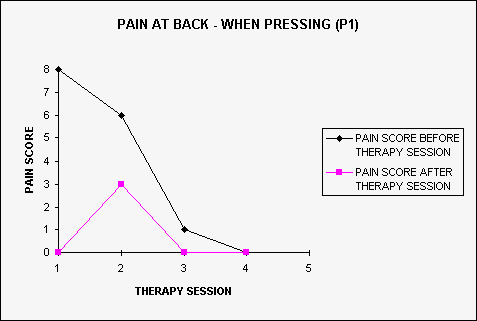
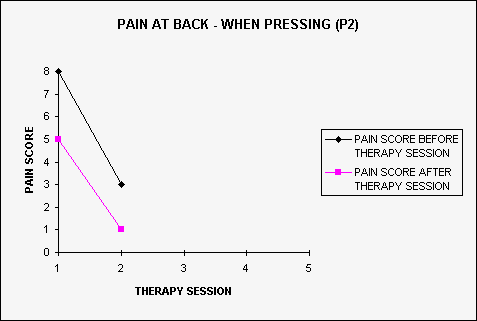
GENERAL COMMENT
1. Pain score was measured by patient, using his best judgment.
2. Pain Score 0 - No pain
Pain Score 10 - Excruciating pain
3. Operator of device was always the same person.
4. Interactive communication was always encouraged between patient and operator of device in order to gauge the degree of improvement in patient's problem as treatment progressed. Treatment ended when patient felt comfortable enough or when pain disappeared.
|
|
|
Chronic Arm Problem |
|
Chronic Numbness At Left Arm
For about 1 year, the patient - a 56 year old lady - had a problem when lifting her left arm upwards. She felt no pain but tightness at her L-ball joint area. She also experienced numbness at her whole left upper and lower arm, at all times of the day.
GENERAL SYMPTOMS EXPERIENCED BY PATIENT:
Prior to the start of Sonotron therapy, the patient complained of tightness and not pain in her L-shoulder joint whenever she lifted her arm. She also complained of constant numbness in her upper and lower L-arm. She reported a tightness score of 10 out of 10 when lifting and a numbness score of 5 out of 10.
RESULT AFTER 1ST THERAPY SESSION ON MAY 16, 1995.
Before the Sonotron treatment, with the help and observation of her daughter, a physiotherapist of the hospital, the patient was asked to locate, by herself, the most tight spot in her L-shoulder. She located it by lifting her own arm when she reported a tightness score of 10 out of 10.
Immediately after the treatment, she reported a slight drop in tightness to a score of 8 out of 10 when lifting. She also reported no more numbness in her upper and lower L-arm. Her numbness score was reported then at 0 out of 10.
RESULT AFTER 2ND THERAPY SESSION ON MAY 17, 1995.
The patient felt a sudden attack of numbness at about 1:00 am in the morning of the next day at her upper and lower L-arm. She had to rub her arm to relieve the numbness. She reported a numbness score of 8 out of 10 during the sudden attack.
Before the 2nd Sonotron therapy session, the patient was asked to assess her difficulty. She reported a numbness score of around 8 out of 10 at her upper and lower L-arm. The ROM (range of motion) of her L-arm was measured with an equipment. The same physiotherapist and the operator measured the degree of maximum upward extension of her L-arm to be 95 degrees but her R-arm was able to lift up to a maximum of 130 degrees.
Immediately after treatment, she registered a score of 0 out of 10 for her numbness. The ROM was measured again and the degree of maximum upward extension was found to be 105 degrees. A 10 degrees increase in ROM was registered.
RESULT AFTER 3RD THERAPY SESSION ON MAY 18, 1995.
After treatment, the patient's numbness came back at about 1:00 am in the morning at her upper and lower L-arm but less than the morning of the day before. She reported a numbness score of 5 out of 10 at that moment.
Before the 3rd therapy session started, she reported a numbness score of only 3 out of 10 at her upper and lower L-arm. The angle of maximum upward extension of her L-arm improved to 100 degrees instead of 95 degrees, as reported a day before, thus giving a 5 degrees difference.
After therapy, she reported no more numbness in her L-arm. The degree of maximum upward extension was increased to 110 degrees, making a difference of 10 degrees for that day itself. The Physiotherapist was happy with the improvement in the patient's ROM. The patient and the physiotherapist evaluated the treatment for the ROM to be "good" and the treatment of her numbness to be "excellent".
RESULT AFTER 4TH THERAPY SESSION ON MAY 19, 1995.
However, the patient's numbness came back at about 2:00 am in the morning only at her upper L-arm but at a very much reduced level than the morning of a day before. She experienced no more numbness at her lower L-arm.
Before the 4th therapy session, she reported a numbness score of only 1 out of 10 on her upper L-arm. The degree of maximum ROM was determined to be 110 degrees, which was the same as the day before.
After the therapy, she experienced no more numbness in her L-arm and the degree of ROM was increased to 115 degrees. She and the physiotherapist evaluated the treatment for numbness to be "excellent" and the improvement in ROM to be "good".
RESULT AFTER 5TH THERAPY SESSION ON MAY 20, 1995.
After the 4th therapy session, the patient experienced no more numbness attack early in the morning.
Before the 5th therapy session, she reported a very slight numbness score of only 0.5 out of 10 in her upper L-arm. The degree of ROM was measured and was observed to maintain at 115 degrees, which was the same as the day before.
After the therapy, she experienced no more numbness in her L-arm and the degree of ROM was drastically increased to 125 degrees. The difference in the angle of maximum upward extension between her L-arm now as compared to that of her R-arm (which was at 130 degrees) was only 5 degrees. The patient and physiotherapist evaluated the treatment for numbness to be "excellent" and ROM to be "excellent" as well.
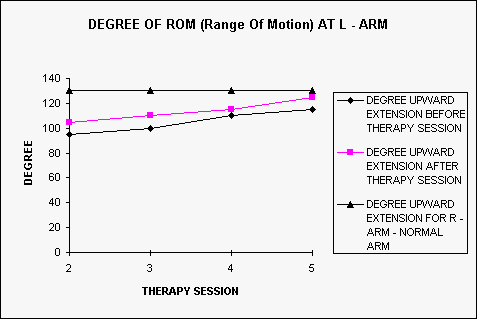

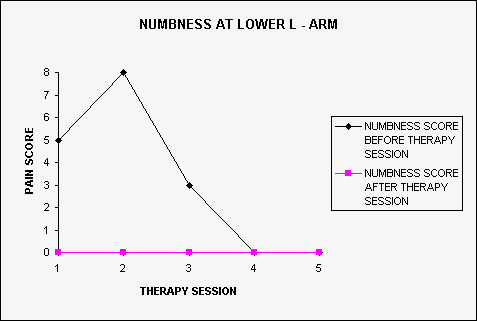
GENERAL COMMENT
1. Pain score was measured by patient, using his best judgment.
2. Pain Score 0 - No pain
Pain Score 10 - Excruciating pain
3. Operator of device was always the same person.
4. Interactive communication was always encouraged between patient and operator of device in order to gauge the degree of improvement in patient's problem as treatment progressed. Treatment ended when patient felt comfortable enough or when pain disappeared.
|
|
|
Spondylolisthesis, (Low Back Pain) |
|
Bank Officer With Spondylolisthesis
MRI ANALYSIS OF LUMBAR SPINE (Copy from report of Radiologist)
Trans-axial T1 weighted, sagittal T1 weighted and 2-D partial flip sequences were obtained. There was 1st degree spondylolisthesis of L4 over L5. Associated pseudo disc herniation or left-behind L4/5 disc was seen. This had caused encroachment of both neural foramina.
The rest of the lumbar disc appeared normal. No intradural nor intramedullary lesions seen. The conus medullaris appeared normal.
Conclusion: 1st degree spondylolisthesis L4 over L5. Associated pseudo disc herniation of L4/5 was seen.
General symptoms experienced by patient:
Prior to the Sonotron therapy, the patient - a bank executive - complained of pain whenever he carried heavy things like an ordinary pail of water or his baby. He reported a pain score of 7 out of 10.
Whenever, he went shopping with his wife, he would have to take a rest after only about 15 to 20 minutes of walking because he felt pain at the back of his trunk, on the left side. The pain, also at a pain level of 7 out of 10, descended downwards to both knees, L-thigh and L-calf muscles.
His right heel/ankle area was also affected and had a pain score of 7 out of 10.
He used "tiger balm" regularly to relief his condition but it always only managed to reduce his perception of pain for a short while.
He had been treated by a major Government general hospital with Short Wave Diathermy for a period of 5 months, before he stopped 3 months prior to Sonotron Therapy. He reported that the therapy didn’t help him at all. Pain killing drugs also failed to work on him.
He had also tried traditional massage but it didn’t help.
RESULT AFTER 1ST THERAPY SESSION ON MAY 11, 1995.
The pain relief lasted the whole day after therapy. He also rested the whole day, as advised.
RESULT AFTER 2ND THERAPY SESSION ON MAY 12, 1995.
In the morning when he woke up, he felt a bit "uneasy". His pain came back but at a lower level than before the start of treatment. He reported a pain score of around 5 out of 10 at his L-trunk, L-thigh, L-knee, L-calf muscle areas and R-heel/ankle, when he rolled over on his side while on bed. Pain at his R-knee was gone.
Just before treatment, he reported a pain score of 4 out of 10 for his L-trunk. Pain at his L-knee was in the region of 4-5 out of 10 and also 4-5 out of 10 for his R-heel/ankle area after walking 15 - 20 minutes. A numbness feeling of 4-5 out of 10 was felt for his L-thigh, L-knee and L-calf muscle area.
Immediately after treatment, he had no more pain at his L-knee but felt only numbness which registered a score of 2 out of 10. He also felt the numbness at his L-thigh and L-calf muscle area had improved to a score of 2 out of 10.
He felt no more pain at his L-trunk and R-heel/ankle area. Pain at his L-knee was also removed totally.
After treatment, he went shopping. He visited The Mall and Subang Parade Shopping Complex in Kuala Lumpur and then back to The Mall - and walked a total of 4 hours. He felt no pain at his problem areas.
Even seven and a half hours later, at about 6 p.m., he observed that he didn’t feel any pain at his L-trunk. However, he felt slight pain at his R-heel/ankle area. The pain score was 2-3 out of 10. He also felt a reduced numbness at his L-knee.
RESULT AFTER 3RD THERAPY SESSION ON MAY 13, 1995.
When he woke up in the morning of the 3rd therapy session, he felt no pain at his L-trunk and R-heel/ankle area. He only felt slight numbness at his L-thigh, knee and calf muscle area. His feeling of numbness was in the region of 2-3 out of 10.
Just before treatment, he reported the same result as the one felt when he woke up.
After therapy, he reported that the numbness of his L-thigh had disappeared. However, he still felt "a little bit" of numbness at his L-knee and L-calf muscle area. His feeling of numbness was around 1-2 out of 10.
After treatment, at around 11:30 am., he drove out of Kuala Lumpur by himself. The journey took one and a half hours because of a traffic jam. However, he felt no pain at all at his problem areas, despite the fact that he had to play frequently with the clutch of his car with his left leg, throughout the journey.
At 6 p.m., he went on a long car journey to Malacca. This time, he didn’t drive. However, despite the long hours of sitting in the car, he felt no discomfort.
About 12 hours after the 3rd therapy session, (at around 11 p.m.) he observed some numbness at his L-thigh and L-calf muscle areas. But he felt no numbness at his L-knee.
Because of the long traveling time from Kuala Lumpur to Malacca, he felt just a little pain at his L-trunk, in the region of 1-2 out of 10.
RESULT AFTER 4TH THERAPY SESSION ON MAY 14, 1995.
When he rolled over on his bed before getting up, he felt no pain at all. However, his feeling of numbness at his L-thigh and L-calf muscle area was around 2-3 out of 10. All the rest were alright.
Immediately after treatment, he felt a total removal of his numbness at the L-thigh and L-calf muscle areas.
After the therapy session, from about 12 p.m. he walked until 8 p.m. - a total of 8 hours - and felt no pain nor numbness at his problem areas. He went shopping from one complex to another.
At about 11 p.m., he felt a very slight numbness of 1-2 out of 10 at his L-thigh and L-calf muscles. However, the numbness was not continuous. It was "on and off", until he went to bed at 1 am.
RESULT AFTER 5TH THERAPY SESSION ON MAY 15, 1995.
When he woke up, he felt all were OK except a very slight feeling of numbness. His numbness score was around 1-2 out of 10 at his L-thigh and L-calf muscle area. He described his numbness to be coming from the surface of his muscles, towards the left of the limb.
After therapy, even though the length of time was about half the usual taken during the previous few sessions, he reported a total reduction of numbness to 0 out of 10, at his L-thigh and L-calf muscle area.
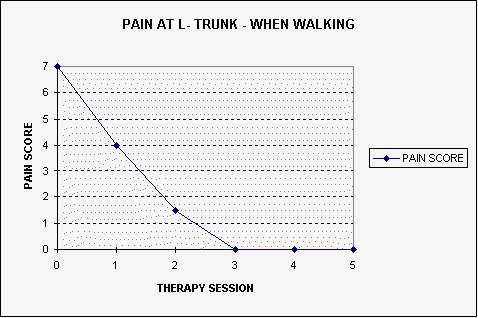
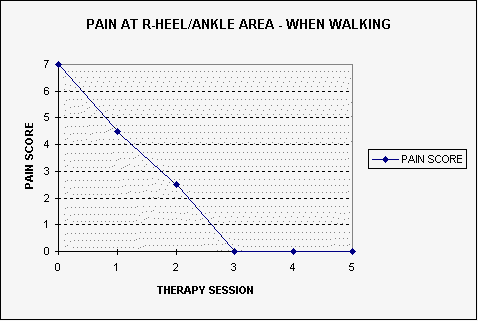

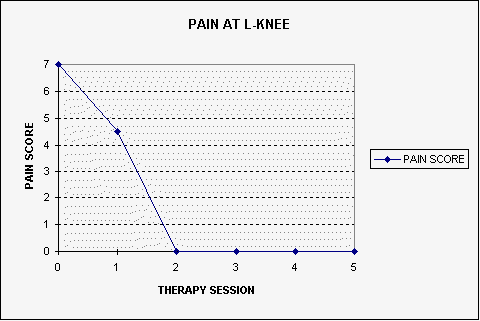
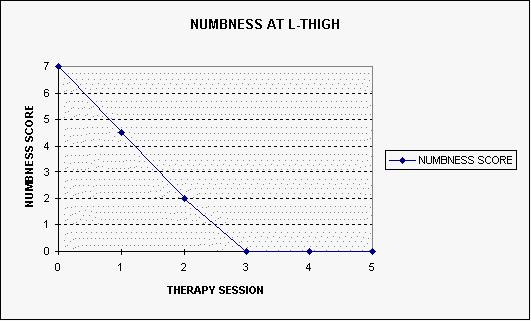


GENERAL COMMENT
1. Pain score was measured by patient, using his best judgement.
2. Pain Score 0 - No pain
Pain Score 10 - Excruciating pain
3. Operator of device was always the same person.
4. Interactive communication was always encouraged between patient and operator of the device in order to gauge the degree of improvement in patient’s problem as treatment progressed. Treatment ended when patient felt comfortable enough or when pain disappeared.
|
|
|
Chronic Knee Pain, Case 1 |
|
Knee Problem of 10 Years
History:
The patient, a 40 year old man, had pain in his left knee for about 10 years. A doctor diagnosed his problem to be caused by thinning of the capsule in his knee joint. Since 7 years back, he could not bend his knee completely. Besides, he also felt pain in this problem area, on and off, for the past 10 years. He was treated with Short Wave diathermy at the hospital for 3 sessions prior to the start of Sonotron Therapy and was on pain killing drugs.
RESULT AFTER 1ST THERAPY SESSION ON MAY 17, 1995.
Prior to the Sonotron therapy, the patient had taken his regular dose of his pain killing drug and was given a session of Short Wave diathermy. Despite the situation, he registered a pain score of 8 out of 10 when he bent his knee with the support of both hands. He was able to bend to a maximum of 90 degrees.
Immediately after the Sonotron treatment, he was able to bend his L-knee completely with only one hand to support his movement with an improvement of his pain score to 6 out of 10.
RESULT AFTER 2ND THERAPY SESSION ON MAY 18, 1995.
Just prior to treatment, he felt less pain than the day before, when he bent his L-knee. He reported a pain score of only 4 out of 10 at his L-knee. He also observed that he was able to bend more. The angle of maximum bending, with the support of only one hand, was measured to be 50 degrees, 10 degrees above the angle of complete flexion of his knee.
Immediately after treatment, he registered a score of 2 out of 10, an improvement in his pain on bending. He was also able to bend his knee completely without any support of either hand.
RESULT AFTER 3RD THERAPY SESSION ON MAY 19, 1995.
Prior to Sonotron Therapy, he reported a pain score of 4 out of 10 in his L-knee. He also observed that he was able to bend completely without support.
After therapy, he reported a pain score of only 2 out of 10 in his L-knee when he bent it. He commented that Sonotron was able to reduce his pain very quickly and effectively and he was very happy with the treatment.
RESULT AFTER 4TH THERAPY SESSION ON MAY 20, 1995.
In the evening of the day before, he exerted himself by taking part in sporting activities. He reported that his pain had increased to a level of 5 out of 10 in his L-knee. He also observed that he was still able to bend completely without support. He was advised to take care and not to overstrain himself again, if possible.
After therapy, he reported a pain score of 1 out of 10 in his L-knee when he bent it. He commented that the pain had reduced drastically.
"Before 17/5/95 I had short wave for 2 sessions, the effect was slow. After the treatment from Sonotron, I feel the effect is faster and better. The pain reduced tremendously and I can bend better without any support. The effect from medication is slow."
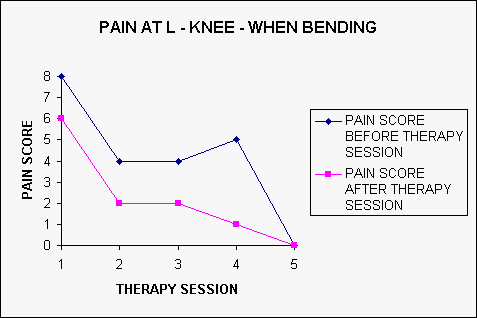
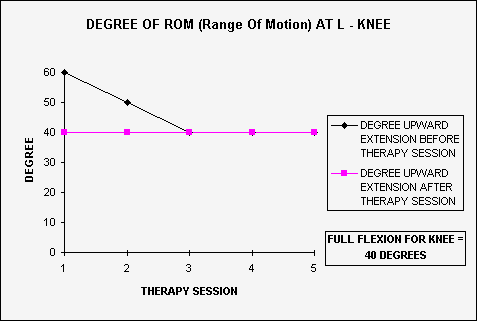
GENERAL COMMENT
1. Pain score was measured by patient, using his best judgment.
2. Pain Score 0 - No pain
Pain Score 10 - Excruciating pain
3. Operator of device was always the same person.
4. Interactive communication was always encouraged between patient and operator of device in order to gauge the degree of improvement in patient's problem as treatment progressed. Treatment ended when patient felt comfortable enough or when pain disappeared.
|
|
|
Chronic Knee Pain, Case 2 |
|
Physiotherapist with Chronic Knee Pain
The patient, a 51 year old Physiotherapist, had pain in her left knee for 1 year. Had undergone physiotherapy treatment with Short Wave, Ultra-sound and Interferential, on and off, for 5 months. Was also on medication (Tilcotil - one tablet daily). She observed no improvement in her condition. She decided to stop the medication 3 months prior to the start of Sonotron Therapy.
GENERAL SYMPTOMS EXPERIENCED BY PATIENT:
Prior to the start of Sonotron therapy, patient complained of pain in her left knee whenever she bent her leg or squatted. She also felt the pain when sitting cross-legged. She could not pray in that position at all. She reported a pain score of 7 out of 10 when bending her legs. Her pain score rose to 9 out of 10 when she forced herself to sit cross-legged. She also observed that her left knee was slightly swollen on one side.
RESULT AFTER 1ST THERAPY SESSION ON MAY 16, 1995.
Before the Sonotron treatment, she was asked to locate by herself, the most painful spot in her knee. She located it by bending her left knee, at which time, she reported a pain score of 7 out of 10 and a pain score of 9 out of 10 when she tried to sit with her legs crossed.
Immediately after the treatment, she felt no more pain. She reported a pain score of 0 out of 10 on bending. When she sat with legs crossed, she only experienced a pain score of 3 out of 10.
RESULT AFTER 2ND THERAPY SESSION ON MAY 17, 1995.
In the morning of the 2nd therapy session, she only felt a bit of pain when sitting cross legged on the floor while praying. She reported her pain score to be around 2 out of 10 at her L-knee. But she didn't feel any pain on bending. It had disappeared. She also observed that the slight swelling on one side of her knee had also disappeared. When she sat cross legged, she experienced a pain score of only 2 out of 10.
Immediately after treatment, she registered an improvement in her pain, at a score of 1 out of 10, when she sat cross legged .
RESULT AFTER 3RD THERAPY SESSION ON MAY 18, 1995.
In the morning of the 3rd therapy session, when she had to sit cross legged during prayer time, she reported a pain score of around 1 out of 10 at her L-knee and her pain on bending did not return even on that day.
After therapy, she reported no pain at all when sitting cross legged on the floor. She commented that she felt much better and her comment about the treatment was "excellent".
RESULT ON MAY 19, 1995.
She reported that she had totally no pain when sitting cross legged on the floor as well as when bending her knees.
Although she was advised to continue with one or two more sessions to get a better overall treatment, she felt it was no longer necessary. Therefore, no treatment was administered to her on that day.
RESULT ON MAY 20, 1995.
The patient felt the same pain-free condition on this day. No treatment was given to her as she felt it was again not necessary.
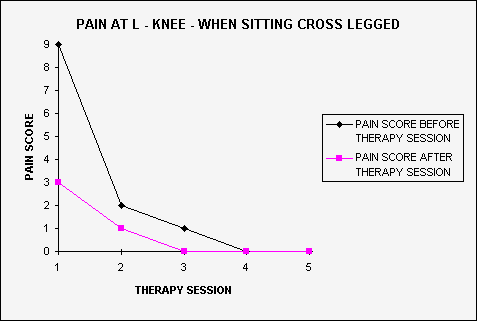
GENERAL COMMENT
1. Pain score was measured by patient, using his best judgment.
2. Pain Score 0 - No pain
Pain Score 10 - Excruciating pain
3. Operator of device was always the same person.
4. Interactive communication was always encouraged between patient and operator of device in order to gauge the degree of improvement in patient's problem as treatment progressed. Treatment ended when patient felt comfortable enough or when pain disappeared.
|
|
|




 Patients' Responses To Sonotron Therapy
Patients' Responses To Sonotron Therapy